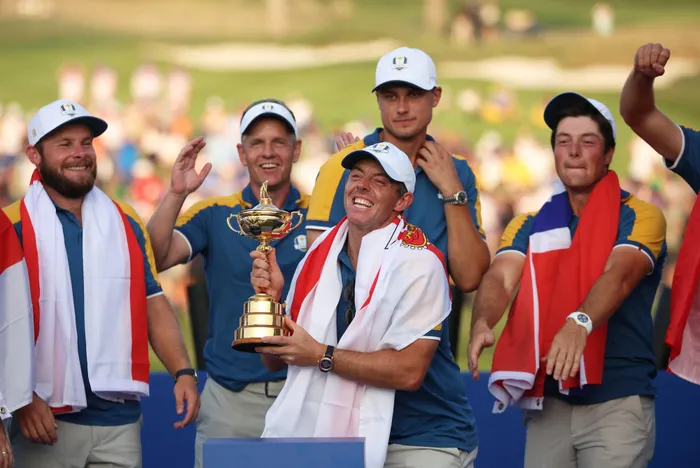When fans cross the line: Ryder Cup abuse sparks debate on sporting etiquette

Team Europe's Rory McIlroy celebrates with the trophy and teammates during the presentation after winning the Ryder Cup as they prepare for this year's tournament.
Image: Phil Noble
Passionate, noisy fans add to the flavour of a live game. The cheers, encouragement and exclamations from the stands always ramp up the atmosphere during a game, and give everyone, players, supporters, and viewers at home a feel of the excitement of a game.
When every success of the home side is celebrated, and every failure is met with groans and similar audible anguish, the game comes alive … There are few experiences that can compare with being there at “THE” game.
We do not have to stretch our memories very far to recall “bubble sport” during the Covid lockdown, and how sterile that was. At one point, cheers had to be piped into stadiums over the sound systems just so that players on the field would not lose motivation.
We all experienced watching games in silence. And we didn’t like it. It was hard to concentrate, hard to stay engaged.
But lately, the pendulum seems to have swung too far the other way.
From Ellis Park to Bethpage Black
In August 2024, the Ellis Park crowd turned hostile during the haka performed by the New Zealand All Blacks. Their boos and chanting all but drowned out the traditional war cry, and a coincidental aeroplane flyover muted the visitors completely.
All Blacks flyhalf Damian McKenzie said he did not enjoy the experience. “You can understand the roars of the crowd, and the music is a little … yeah,” he said, and added, “I probably don’t agree with it as much.”
That moment sparked debate over when crowd behaviour crosses the line. Some argued that visitors are fair game; others called for respect for tradition. But over time, the noise around this debate eventually died down.
Until this past weekend, the hostility came not at a high-octane rugby clash, but on the fairways of a golf tournament.
Europe triumphs, but crowd steals the headlines
The 45th Ryder Cup, held at Bethpage Black in New York, ended with Team Europe retaining the trophy after a 15-13 victory over the United States.
Europe had dominated the first two days, building a commanding 12-5 lead. What looked like a record-breaking rout turned into a desperate scrap when the Americans mounted a dramatic singles fightback. The fightback seems to have been borne on the back of how the US supporters behaved toward the European team.
The final 15-13 result was the tightest since 2012. Also, it was Europe’s first Ryder Cup win on US soil since 2012 — but the victory was overshadowed by the behaviour of the home crowd.
A toxic atmosphere
Bethpage Black’s galleries were described as “unrecognisable from golf’s genteel archetype,” turning into a bear pit of insults, expletives, xenophobia and vulgar chants. Many called it the most abusive Ryder Cup in nearly a century.
McIlroy and his wife, Erica, were frequent targets. During Saturday’s play, Erica was struck by a drink thrown by an American fan. Shane Lowry, who was paired with McIlroy, said the abuse she received was “astonishing”.
Other flashpoints included:
- An American course announcer directed a vulgarity at McIlroy and led a chant of “f*** you, Rory” before stepping down.
- Anti-Irish and homophobic slurs, along with jibes about McIlroy’s personal life.
- Squeaky rubber ducks, handed out with drinks, used to disrupt European shots.
- Lowry targeted with taunts about his weight and being called McIlroy’s “boyfriend”.
McIlroy eventually snapped, swearing at a spectator mid-round. By the end of the tournament, he had to be flanked by state troopers for protection.
Backlash and apologies
McIlroy condemned the behaviour, calling it “unacceptable and abusive”. He stressed that golf should be held to higher standards, rooted in etiquette and respect. “I was annoyed that there were a lot of people shouting against me, rather than supporting their own players,” he said, pointing to world No.1 Scottie Scheffler.
The PGA of America was forced to deploy extra security, with police and dogs lining the fairways.
American great Tom Watson apologised to Europe for the “rude and mean-spirited behaviour,” admitting he was “ashamed”. US player Justin Thomas tried to calm the galleries, reminding fans that “words hurt, too”.
Despite the hostility, the Europeans had the final word. “We shut them up,” McIlroy said after sealing another Ryder Cup win. But sadly, this 2025 tournament will be remembered for all the worst reasons.
Related Topics: